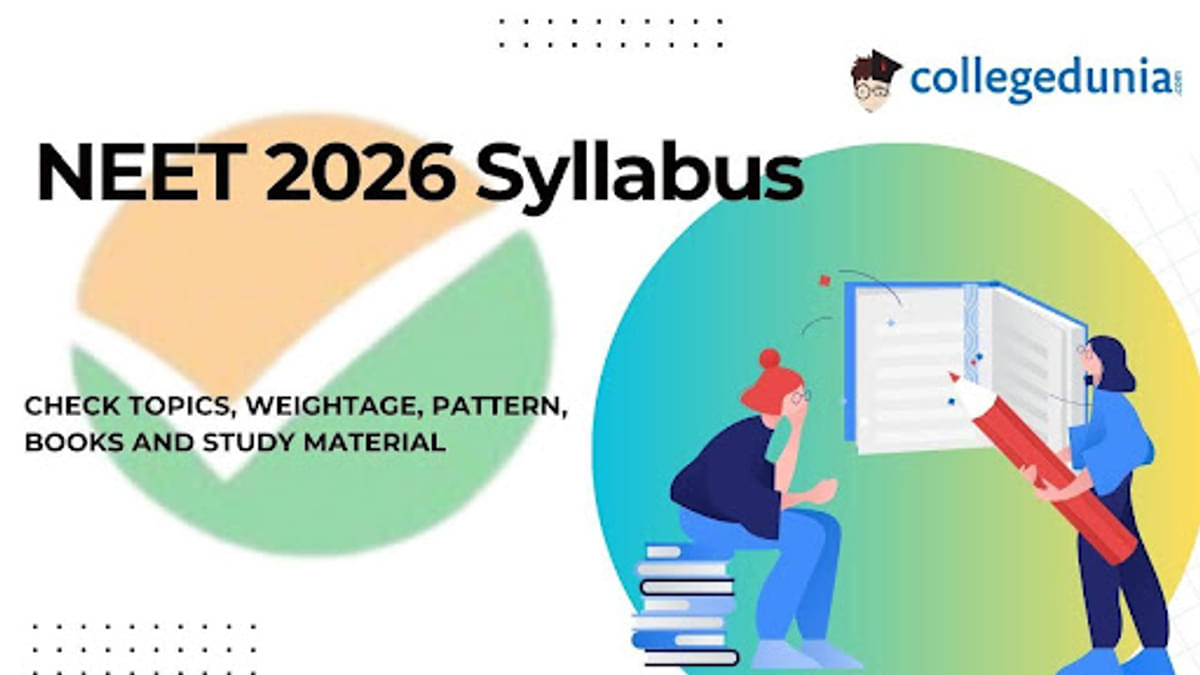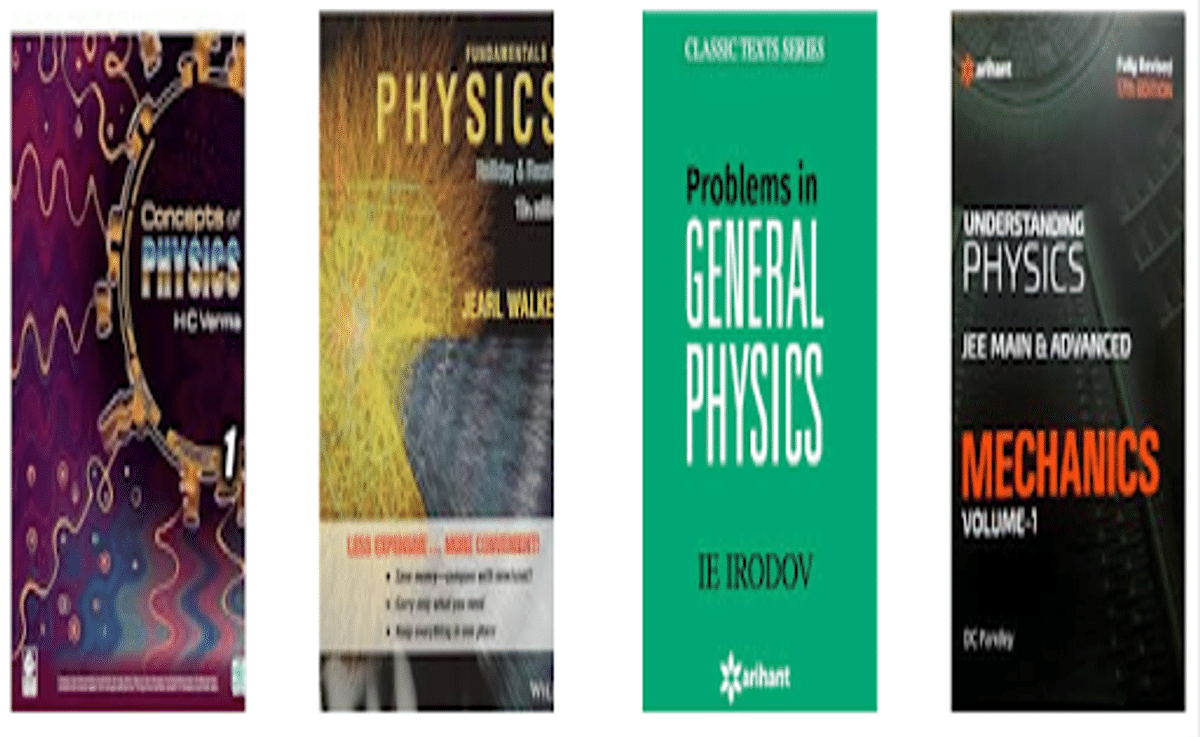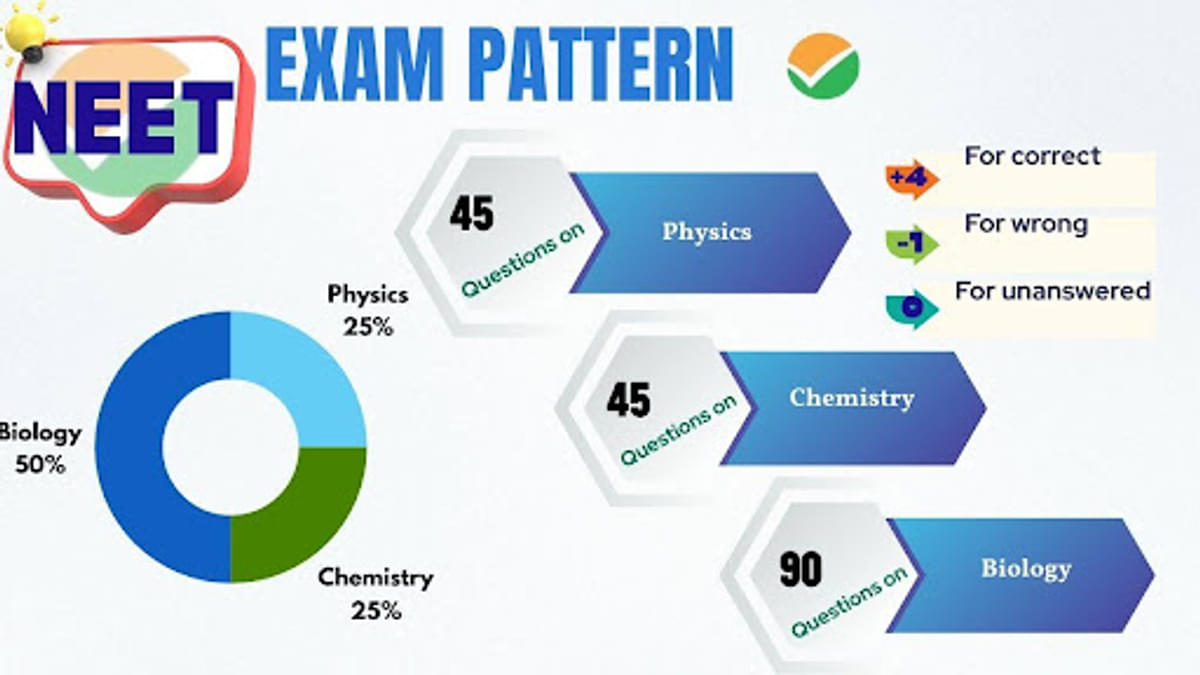NEET 2026 syllabus PDF will be released by NTA on the official website at neet.nta.nic.in. The syllabus for NEET 2026 is based on the NCERT syllabus for classes 11th and 12th for Physics, Chemistry, and Biology.
- The NEET 2026 syllabus for Physics includes topics like Mechanics, Modern Physics, Optics, Electrodynamics, and Thermodynamics.
- For Chemistry, important topics in the NEET syllabus 2026 include Chemical Bonding & Molecular Structure, Thermodynamics and Equilibrium, Coordination Compounds, and Organic Chemistry.
- NEET 2026 syllabus for Biology includes chapters such as Human Physiology, Genetics and Evolution, Ecology and Environment, Plant Physiology, and Cell Structure & Function.
- A total of 180 questions will be asked from the NEET 2026 syllabus PDF, with 45 questions each from Physics and Chemistry, and 90 questions from Biology.
- A maximum of 720 marks can be scored in the NEET 2026 syllabus.
Also Read
Official NEET 2026 Syllabus PDF
| NEET UG Syllabus 2026 | Links |
|---|---|
| NEET UG 2026 Physics Syllabus | Download pdf |
| NEET UG 2026 Chemistry Syllabus | Download pdf |
| NEET UG 2026 Biology Syllabus | Download pdf |

Key Summary
- The NEET Syllabus 2026 is divided into 3 sections, including Physics, Chemistry, and Biology.
- NEET 2026 syllabus for Physics includes topics from Mechanics, Electromagnetism, Optics, and Modern Physics.
- Topics from Physical Chemistry, Inorganic and Organic Chemistry are included in NEET 2026 syllabus for Chemistry.
- NEET syllabus 2026 for Biology includes topics from Zoology and Botany.
- NEET 2026 syllabus for Physics and Chemistry has a weightage of 45 questions each, and Biology alone has a weightage of 90 questions.
- A total of 720 marks can be scored from the NEET 2026 syllabus, with 180 each from Physics and Chemistry, and 360 from Biology.
NEET 2026 Syllabus for Physics
The NEET 2026 syllabus for Physics is based on topics including Mechanics, Electromagnetism, Optics, and Modern Physics. Aspirants can check the unit-wise NEET syllabus for Physics in the table below.
| Unit | Topics |
|---|---|
| Physics and Measurement | SI Units, dimensional analysis, errors in measurements |
| Kinematics | Motion graphs, uniformly accelerated motion, vectors, projectile motion |
| Laws of Motion | Newton's laws, friction, and dynamics of circular motion |
| Work, Energy, and Power | Work-energy theorem, potential energy, collisions. |
| Rotational Motion | Moment of inertia, torque, angular momentum, rotational equilibrium |
| Gravitation | Kepler's laws, escape velocity, and motion of satellites |
| Properties of Solids/Liquids | Stress-strain, viscosity, surface tension, heat transfer |
| Thermodynamics | Laws of thermodynamics, isothermal and adiabatic processes |
| Kinetic Theory of Gases | Gas laws, degrees of freedom, RMS speed of gas molecules |
| Oscillations and Waves | SHM, waves, superposition, beats, standing waves |
| Electrostatics | Coulomb's law, Gauss's law, potential energy, capacitors |
| Current Electricity | Ohm's law, resistors, cells, Kirchhoff's laws, Wheatstone bridge |
| Magnetism | Ampere's law, Biot-Savart law, torque on a current loop, magnetic dipole |
| EM Induction/AC | Faraday's law, inductance, AC circuits, transformers |
| Electromagnetic Waves | Displacement current, electromagnetic spectrum, applications |
| Optics | Reflection, refraction, lenses, microscopes, wave optics, polarization |
| Dual Nature of Matter | Photoelectric effect, de Broglie waves |
| Atoms and Nuclei | Bohr model, hydrogen spectrum, nuclear energy |
| Electronic Devices | Diodes, rectifiers, transistors, logic gates |
Important Books for NEET Physics
| Books | Author/Publisher |
|---|---|
| Concepts of Physics | H.C. Verma |
| Fundamentals of Physics | Halliday, Resnick, and Walker |
| Problems in General Physics | I.E. Irodov |
| Understanding Physics | D.C. Pandey |

Also Read
NEET 2026 Syllabus for Chemistry
The NEET 2026 syllabus PDF for Chemistry is divided into 3 sections, including Physical Chemistry, Organic Chemistry, and Inorganic Chemistry, as discussed below.
Physical Chemistry
| Unit | Topics |
|---|---|
| Some Basic Concepts | Mole concept, stoichiometry, laws of chemical combination |
| Atomic Structure | Bohr model, quantum numbers, orbitals, electronic configuration |
| Chemical Bonding | VSEPR theory, hybridization, molecular orbital theory |
| Thermodynamics | Laws, enthalpy, spontaneity, Gibbs free energy |
| Solutions | Colligative properties, Raoult's law, osmotic pressure |
| Equilibrium | Law of mass action, acids-bases, pH, solubility product |
| Redox Reactions | Oxidation-reduction, balancing redox equations |
| Electrochemistry | Electrolytic cells, Nernst equation, conductance |
| Chemical Kinetics | Rate laws, zero/first-order reactions, Arrhenius equation |
Inorganic Chemistry
| Unit | Topics |
|---|---|
| Classification of Elements | Modern periodic table, trends in properties |
| P-Block Elements | Group 13-18, properties and trends |
| d- and f-Block Elements | Transition metals, lanthanoids, actinoids, properties |
| Coordination Compounds | Werner's theory, IUPAC nomenclature, CFT |
Organic Chemistry
| Unit | Topics |
|---|---|
| Basic Principles | Isomerism, electronic effects, types of reactions |
| Hydrocarbons | Alkanes, alkenes, alkynes, aromatic hydrocarbons |
| Organic Halides | Reactions of alkyl/aryl halides, environmental issues |
| Alcohols, Phenols, Ethers | Properties, reactions, dehydration, acidity |
| Carbonyl Compounds | Aldehydes, ketones, nucleophilic addition, tests |
| Carboxylic Acids | Acid strength, factors affecting acidity |
| Amines | Classification, basicity, reactions |
| Biomolecules | Carbohydrates, proteins, nucleic acids, vitamins |
Important Books for NEET Chemistry
| Books | Author/Publisher |
|---|---|
| Physical Chemistry | P.W. Atkins |
| Organic Chemistry | Morrison and Boyd |
| Inorganic Chemistry | J.D. Lee |
| Organic Chemistry | O.P. Tandon |

Also Read
NEET 2026 Syllabus for Biology
NEET 2026 syllabus for Biology includes topics from Zoology and Botany, with some important topics including Human Physiology, Genetics and Evolution, Ecology and Environment, Plant Physiology, and Cell Structure & Function.
Unit-wise NEET syllabus for Biology is discussed in the table below.
| Unit | Topics |
|---|---|
| Diversity in Living World | Classification of plants, animals, fungi; five-kingdom system |
| Structural Organisation | Animal tissues, plant anatomy, and morphology |
| Cell Structure/Function | Cell theory, organelles, cell cycle, mitosis, meiosis |
| Plant Physiology | Photosynthesis, respiration, and plant growth regulators |
| Human Physiology | Digestion, respiration, circulation, excretion, nervous and muscular systems |
| Reproduction | Plant reproduction, human reproduction, reproductive health |
| Genetics and Evolution | Mendel's laws, the molecular basis of inheritance, and evolution theories |
| Biology and Human Welfare | Diseases, immunity, and microbes in human welfare |
| Biotechnology | Genetic engineering, applications in medicine and agriculture |
| Ecology and Environment | Ecosystems, biodiversity, conservation, and environmental issues |
Important Books for NEET Biology
| Books | Author/Publisher |
|---|---|
| Trueman’s Biology (Part 1 and Part 2) | K.N. Bhatia and M.P. Tyagi |
| Objective Biology | Dinesh & K.D. Tripathi |
| Biology for NEET | C.P. Bansal |
| Biology Vol 1 & 2 | Dr. S. S. Bhatt |

Also Read
NEET 2026 Exam Pattern
As per the NEET 2026 exam pattern, the examination will be conducted in offline mode. The NEET Question paper will comprise 3 sections like Physics, Chemistry, and Biology.
- 45 questions will be asked, each from Physics and Chemistry.
- 90 questions will be asked from the NEET 2026 syllabus for Biology.
- Students will be required to solve a total of 180 questions in 3 hours.
- Total marks in NEET are 720, with 180 marks each from Physics and Chemistry and 360 marks from Biology.
| Particulars | Details |
|---|---|
| Mode of Examination | Offline- pen and paper-based |
| Number of Sections in NEET 2026 | 3 sections |
| NEET 2026 Sections |
|
| Type of Questions in NEET 2026 | MCQs |
| Number of Questions in NEET 2026 | 180 |
| NEET Section-Wise Number of Questions |
|
| NEET Total Marks | 720 |
| NEET Section-Wise Marks |
|
| NEET 2026 Exam Duration | 3 hours |
| NEET 2026 Marking Scheme |
|
Source- NEET official brochure

Also Read
NEET Syllabus 2026 Preparation
Key Tips for NEET 2026 Preparation:
- Focus on NCERT: NEET is based on NCERT concepts, especially for Biology, so focus on thoroughly reading and understanding your NCERT textbooks.
- Strengthen Weak Areas: Spend more time on subjects or topics you find difficult.
- Practice Time Management: During mock tests, practice solving questions within the time limit to improve speed and accuracy.
- Revision: Regularly revise to ensure concepts are fresh in your memory.
- Health & Well-being: Take breaks, sleep well, and stay hydrated. Mental well-being is crucial for focus and retention.
Also Read
NEET Syllabus 2026 FAQs
Ques. Will syllabus change in 2026 NEET?
Ans. NTA has recently made some changes to the NEET syllabus. However, in 2026, the syllabus is expected to remain the same as the NEET syllabus for last year. Changes made by NTA in the NEET syllabus are discussed below.
| Subject | Topics Removed |
| Physics | Rolling motion, Reynolds' number, heat engines and refrigerators, forced and damped oscillations, Doppler effect, Van de Graff generator, color coding, potentiometer, cyclotron, Davisson-Germer experiment, alpha, beta, and gamma decay, and transistors |
| Chemistry | Hydrogen, s-block, Environmental Chemistry, States of Matter, Solid State, Chemistry in Everyday Life, Metallurgy, Polymers, and Surface Chemistry |
Ques. Will NEET 2026 be tough for MBBS?
Ans. Difficulty level of NEET question paper is not fixed by NTA. However, as per the NEET paper analysis from past years’, the difficulty of the NEET question paper was higher in 2026 and is expected to be similar or slightly lower in difficulty level in 2026.
Ques. Should I prepare for NEET 2026?
Ans. Yes, it is recommended to start NEET 2026 preparation as early as possible, keeping in view the length of the NEET 2026 syllabus. To effectively prepare for NEET 2026, students must collect relevant study material, prepare a study plan, solve previous years’ papers, and appear for NEET mock tests regularly.
Ques. Who is eligible for NEET exam 2026?
Ans. As per the NEET 2026 eligibility criteria prescribed by NTA, candidates must have completed 17 years of age as on 31 December 2026. Candidates must have completed class 12th with at least 50% marks aggregate in Physics, Chemistry and Biology.
Ques. Is NEET 2026 conducted in two phases?
Ans. The NEET examination is conducted once every year by NTA. This year also, NTA is expected to conduct NEET 2026 once.
Ques. Which year was NEET considered the toughest?
Ans. The NEET 2016 paper is widely regarded as the toughest, especially due to its Physics section. It featured concept-based numerical problems that demanded in-depth knowledge and problem-solving skills.
Ques. Is frog included in NEET 2026 syllabus?
Ans. Yes, frog is included in the NEET 2026 syllabus. It falls under the chapter “Structural Organization in Animals” and covers topics like the morphology, anatomy, and functional systems of frogs, along with cockroach studies.
Ques. Is Section B removed from NEET 2026?
Ans. Yes, Section B has been removed from NEET 2026. The new format includes only 180 compulsory multiple-choice questions with no optional questions.
Ques. Is 590 a good score in NEET?
Ans. Yes, scoring 590 in NEET is considered good and can help candidates secure admission in reputed medical colleges such as:
- Indira Gandhi Government Medical College – Maharashtra
- G.S.V.M. Medical College – Uttar Pradesh
- Osmania Medical College – Telangana
- Pt. Raghunath Murmu Medical College – Odisha
- Govt. Medical College ESI & Hospital – Tamil Nadu
- Tirunelveli Medical College – Tamil Nadu
- MKCG Medical College – Odisha
- Jawaharlal Nehru Medical College – Rajasthan
- Pandit Deendayal Upadhyay Medical College – Gujarat
- Sri Venk









Comments